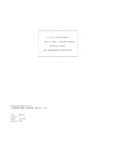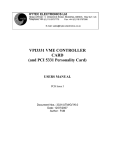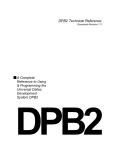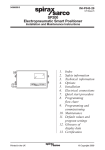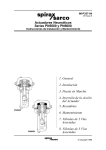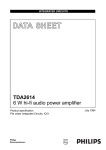Download User Manual - Hytec Electronics Ltd
Transcript
*******************************************
*
*
*
*
LP 1342 LIST PROCESSOR
*
*
*
*
512K OR 1024K, 7 TRIGGER VERSION
*
*
*
*
TECHNICAL MANUAL
*
*
*
*
AND PROGRAMMING INSTRUCTIONS
*
*
*
*
*******************************************
HYTEC ELECTRONICS LTD.,
5 CRADOCK ROAD, READING, RG2 0JT, U.K.
Doc:
Issue:
Date:
Author:
UM1342
B
05/07/01
PJM
*
*
August 1995
ENGINEERING NOTICE
FURTHER IMPORTANT ENHANCEMENTS TO LP 1341/2 LIST PROCESSOR
As the result of continuing improvement of Hytec's products, another new artwork
for the LP1341/2 has been produced, Issue 4.
The aims of this revision are as follows: a)
To incorporate minor corrections to the Issue 3 artwork, which have no
effect on the characteristics of the unit.
b)
To make two distinct changes to the design in line with customer requests
for enhancements, namely: i)
More data memory: the unit can now accept bigger memory chips, so that it
may have up to 1 megaword by 24 bits of data memory.
ii)
Programmable self-trigger rate. The old scheme gave the user two internal
trigger frequencies selected by jumpers, which were virtually useless. These
have been deleted and replaced by a divided crystal oscillator capable of
outputting a variety of frequencies from 0.005 Hz to 600 KHz.
The LP 1341 is still produced by Hytec using this board, with the smaller memory
chips, giving 128K or 256K words of data memory, and without any self-trigger
facility.
A new unit, called the LP 1342, is now offered by Hytec, using this board, which
has larger memories of 512 or 1024K words, and the new programmable self trigger
scheme. However, the self trigger feature makes use of the comparator register
to store the desired frequency value, which means that operationally, you
cannot use both functions, just one at a time.
This manual concerns itself ONLY with the board built as an LP 1342.
Doc:
UM1342
Issue: B
Date: 05/07/01
Page: 1/20
Author: PJM
CONTENTS
Page
Module Data Sheet
2/3
1.
Introduction
4
2.
Configuring
5
3. Detailed Operational Description.
7
3.1
Starting
8
3.2
Stopping
9
4.
Operating Example.
12
5.
Seven Trigger Operation.
13
6. Main Logic Sequencer.
14
7.
Handy Hints and Conditional Jumping.
15
8.
Physical and Electrical.
16
9.
Parts List.
18
Doc:
UM1342
Issue: B
Date: 05/07/01
Page: 4/20
Author: PJM
1. Introduction
This manual is really aimed at people who have already used the LP1340 List
Processor or the T7 (seven trigger) variant and are familiar with the basic
principles of operation of Auxiliary Controllers in CAMAC Crates. Those who do
not have that experience should read the data sheet and this manual very
carefully before making a start. The best way to find out how to operate this
module is to start with the example given and then progress from there. Section
7 contains a lot of valuable information about the possible pitfalls in setting
this device to work and some more detailed information about how the hardware
actually works.
Users of the LP1340/T7 will find that this unit will run the same software as
that unit, except that bits 5-8 of the LAM registers will always be read as '1'
by the commands F(1) A(12,13,14), so they should be masked off by software.
After you have studied the data sheet on the module, this manual will outline
the basic principles of operation of the unit, what options are available and
how it differs from its predecessor, the LP 1340.
The major differences between this unit and the LP 1340 are as follows: a)
Larger Memories:
Data Store is 512K x 24 bits, optionally 1024K
Instruction Store is 8K x 16 bits and can be EEPROM.
b)
New Jump Instruction Format:
The new Jump Instruction Format is as follows:
|16 |15 |14 |13 |12 |11 |10 | 9 | 8 | 7 | 6 | 5 | 4 | 3 | 2 | 1 |
1
1
\ /
JUMP
JC2 JC1 JC0 A11
|
|
|
\
\
/
\/
JUMP CONDITION SPECIFIERS
A1
/
DESTINATION ADDRESS
The Jump Condition Specifiers operate as follows: JC2
JC1
JC0
0
0
0
0
1
1
1
1
0
0
1
1
0
0
1
1
0
1
0
1
0
1
0
1
ACTION
Unconditional Jump
Jump if No Q response during last CAMAC cycle
Jump if data read greater than stored value
Jump if data read less than stored value
Jump unconditionally and await trigger
Jump if No Q and await trigger
Jump if data read equal to stored value.
Jump (unconditional) and restore Write Data Pointer.
Doc:
UM1342
Issue: B
Date: 05/07/01
Page: 5/20
Author: PJM
The "Stored value" referred to above means the data written into the LP 1342's
Comparator Register [F(17) A(3)] which can then be compared with actual Read
Data obtained by the LP 1342 during the last dataway READ command it performed.
This feature CANNOT be used if the programmable trigger is in operation [see f)
below].
c)
The List Processor may now read its own Instruction Pointer.
A modification has been incorporated to allow the LP1342 to read its own
Instruction Pointer so that blocks of read data from different triggers can be
distinguished by incorporating a "Read Instruction Pointer" command as the first
in each list. The Q response to F(1) A(0) has been changed to Q=1 for this
command so that the data read is retained.
d)
Multiple Trigger Inputs.
The LP 1342 has seven trigger inputs via a front panel 9-way Cannon connector,
which invoke a "bootstrap" program [see sect. 5] which results in an internal
jump to the start of the chosen list. As we shall see later, one of the triggers
(Trigger 1) may be used in the same way as the old LP1340 trigger, also, the
LEMO Trigger input with its LAM links can still be used as Trigger 7.
e)
The Control Register is NOT fitted.
This register, which used to work with the LP 1340's loop counter/comparator, is
not fitted in the LP 1342 and is replaced by a data comparator, permitting "JUMP
if Greater Than" type instructions. The "Jump and Await Trigger" function,
formerly derived from a bit in the control register, is taken over by bits in
the new Jump Instruction Format as seen above. This register is dual purpose, as
it is used for the programmable trigger also.
f)
Programmable Internal Trigger
If comparator operations are not needed, the register at subaddress A(3) can be
used to control the on-board self-trigger using the bottom 6 bits. Fit jumper JP
29 and when triggers are enabled you can get the following frequencies applied
to trig. 1.
[Bits 4,5 and 6 control a decade divider; bits 1,2 and 3 control a programmable
'divide-by-twelve' counter.]
Bits
6 5 4
1
1
1
1
0
0
0
0
1
1
0
0
1
1
0
0
1
0
1
0
1
0
1
0
0.06 Hz
600 Hz
6 Hz
60 KHz
0.6 Hz
6 KHz
60 Hz
600 KHz
Bits
3 2 1
1
1
1
1
0
0
0
0
div.
div.
div.
div.
div.
div.
div.
div.
1
1
0
0
1
1
0
0
1
0
1
0
1
0
1
0
by
by
by
by
by
by
by
by
12
3
5
10
6
2
4
1
Doc:
UM1342
Issue: B
Date: 05/07/01
Page: 6/20
Author: PJM
2. Configuring
Before the List Processor can be assembled into a CAMAC system, its operating
mode must be decided, and its internal links set accordingly. These are as
follows: JP1-JP23
Links to permit the appearance of a given LAM
to start execution of a list of instructions. Note
that this is "wire ORed" with the LEMO Trigger
Input (front panel) and that use of both at the
same time is inadvisable. In the case of the
LP1342, this trigger input (and also the LAM
triggers) are wired in as TRIGGER 7. JP1
connects in LAM1 and so on. Fit only one.
Note: All triggers are level sensitive. (Sect. 5)
Standard Setting:
JP24,25,26
All OUT.
OVERFLOW SELECT
If any of these three links is fitted, then as
soon as the TOP 8 or 16 BITS of the corresponding
pointer reaches the "all ones" state, the LP1342
will stop, setting NO X and FINISHED as it does
so. This therefore represents OVERFLOW WARNING.
See also Section 7 (b).
JP24
selects the top 8 bits of the Instruction Pointer
(Note that overflow is on all 16 bits, not just
the 13 bits of the "real" 8K pointer).
JP25
selects the Read Data Pointer (Note that since
the data memory is now 512K or even 1024K, both
read and write data pointers are 24-bits, although
only 19 or 20 bits have any real meaning. Thus
overflow is on bits 9-24).
JP26
selects the Write Data Pointer
Standard Setting - All OUT
JP27/JP28
STOP/VETO
This determines the function of the Stop/Veto
input as follows:JP27 - STOP. If the front panel input is taken
low, the List Processor will stop after the
current instruction, and set FINISHED and NO Q
Status.
Doc:
UM1342
Issue: B
Date: 05/07/01
Page: 7/20
Author: PJM
JP27/28 cont.
JP28 - VETO.
If the input is low at the time
that the LP1342 advances to the next instruction,
the relevant Data Memory Pointer will not be
incremented (data will be ignored). Clearly this
only applies if reads are being performed, and
some external module is looking at data patterns
and issuing VETO accordingly.
To be effective, the VETO input must be taken low
no more than 500nS after the beginning of the
LP1342's CAMAC Cycle, and should be held low until
the end of that CAMAC cycle.
Standard Setting - JP 27 IN.
Note that in order to satisfy a number of applications where the absence of Q
means "No Data Ready", this condition has been made an internal source of VETO
(i.e. ignore data).
The effect of this will be to prevent the incrementing of pointers, which will
mean that data will simply be ignored, when performing commands in Q Ignore Mode
(either Reading or Writing), e.g. Selective Set LAM Mask, Read LAM Status.
If, therefore, your list will include instructions involving reading or writing
without expecting Q=1 and you want the pointer(s) to increment, please contact
Hytec for details of the required modification.
JP29
JP31
JP32
JP33
JP34
Self-Trigger Select. In = Self-Trigger Active, Out
means Not Active, Register at A(3) may be used in
Comparator Mode.
128K memory chip use only: do not fit.
512K memory chip use only, must be fitted.
128K memory chip use only: do not fit.
512K/1024K Memory Select.
JP34 IN - 1024K Memory
JP34 OUT - 512K Memory (512K memory mapped twice
over 1024K area to allow proper overflow)
3.
Detailed Operational Description
The List Processor LP1342 is an ACB Auxiliary Controller in accordance with EUR
6500. As such, it must reside in a CAMAC Crate, connected to an ACB Master
Controller in stations 24 and 25 by a rear-panel 40-way ACB cable and a set of
Request/Grant cables at the front. The user must connect Request to Grant In on
the highest priority controller, and then Grant Out on that controller to Grant
In on the next lowest priority device and so on.
Doc:
UM1342
Issue: B
Date: 05/07/01
Page: 8/20
Author: PJM
It is left
bearing in
importance
responding
to the user to decide the order of priority of the controllers,
mind their relative needs in terms of desired operating speed and
of controlling actions. The LP1342 is capable of accepting and
to ACL, but cannot generate it itself.
Having configured the LP1342, assembled the modules in the crate and connected
up the ACB etc., the user can now switch on and program the LP1342 with its
list(s) of commands and Write Data (if any) as follows: Test
not.
will
will
Booked F(27) A(0) - This tells you if the List Processor is available or
If you get Q, OK to proceed. The List Processor is now booked to you and
give NOT Q to all subsequent Tests by other potential users. The LP 1342
not GO unless it has been BOOKED.
FROM NOW ON WE ARE GOING TO CONSIDER THE PROGRAMMING OF THE LP1342 AS A
"STANDARD" LIST PROCESSOR, FOR THE DETAILS OF HOW TO USE THE SEVEN TRIGGERS, SEE
SECTION 5.
Write Instruction Pointer - F(17) A(0) - To point to the start of the list of
instructions you are going to write into the Instruction Store.
Write Instruction Store - F(16) A(0) - Write a sequence of NAFs into the Store
at incrementing addresses (this happens automatically); not necessary, of
course, if they are already programmed in and you are just going to execute them
again.
Finish with either a STOP instruction, or a JUMP instruction. Don't forget to
add the Q IGNORE bit to any command where the module in question will only give
X but not Q in valid circumstances. If you do not do this, the LP1342 will
repeat the command for about 10 uSec and then STOP, setting the NO Q status bit.
Write Instruction Pointer again, to point to List Start. Remember that for seven
trigger operation, this must be at zero since that is where the "bootstrap" jump
instructions should be loaded. For "normal" operation, with dataway GO or
Trigger 1, you can start anywhere.
Write Write-Data Pointer - F(17) A(1) - Point to the beginning of an area of
data memory into which you are going to put Write Data to be used by the LP1342
when it executes a command involving F16 and not F8.
Write Data Memory using Write Pointer - F(16) A(1) - Writes a sequence of data
words into Memory (pointer auto-increments).
Write Write-Data Pointer again to point at the start.
Remember that you can use the "Jump and Restore Write Pointer" command to re-use
a set of 'constant' or 'setup' data.
Doc:
UM1342
Issue: B
Date: 05/07/01
Page: 9/20
Author: PJM
Write Read-Data Pointer - F(17) A(2) - To point to the start of the area of data
memory to be used to store data read from modules during valid instructions
which had neither F16 nor F8 present AND which gave a TRUE Q Response.
Clear LAM Status Register (All bits) - F(23) A(12) - data 'F' HEX to clear the
GO bit and any other status bits set by the previous sequence.
Clear LAM Mask Register (All bits) - F(23) A(13) - data 'F' HEX again, then:
Selective Set LAM Mask Register - F(19) A(13) - using appropriate bits to allow
End status conditions to generate an Interrupt via LAM.
3.1
Starting
The List Processor is now ready to be started. In the "STANDARD" mode we are
discussing now, this can be done in two ways; either by selectively setting the
GO bit, bit 4, in the LAM Status Register (F(19) A(12)), or by Enabling Trigger
- F(26) A(0) and giving the module an active LOW TTL trigger pulse on TRIGGER 1
via the front panel 9-way Cannon Trigger Input socket. Note that Trigger 1
causes the LP1342 to look at the instruction it is pointing at and if it is NOT
a jump instruction, it will start executing commands as usual. In this way it
can be made "Compatible" with existing LP1340 units. Having been placed in the
"GO" condition by either of these means, the LP1342 will start doing CAMAC
cycles at high speed (about 1.5 uSec each if "unopposed") until it reaches a
Stop condition.
The command Test GO/Trig Enb. - F(27) A(1) - can be used to test whether the
List Processor is Running or Awaiting Trigger. In either case, it would be
disastrous for a computer to attempt to access the LP1342's internal registers
at this time. Note that because the List Processor runs so fast, it is quite
possible that if you tell it to GO, by setting bit 4 in the Status Register,
then by the time you come back to ask it if it is running, it will have
finished!
Whilst Execution is in progress, it is in fact possible to access all the
internal registers of the LP1342 and some users successfully do this, although
the data sheet implies that this is not so. This is because some of the commands
to be "excluded" do not generate Q anyway, so that the only way to signal their
nonacceptance would be to give NO X. This is thought to be at best misleading.
Reading the LP1342's LAM Status Register whilst execution is under way will show
8 bits of data. The bottom 3 bits (the End condition bits) should all be zero;
bit 4 should be a '1' if you set it to start, (this does not happen if the LP
is Triggered); bits 5 to 8 will all be read as '1' and they should be ignored.
Doc:
UM1342
Issue: B
Date: 05/07/01
Page: 10/20
Author: PJM
3.2
Stopping
( See also the IMPORTANT NOTE - Page 11 ).
There are a number of ways in which execution of a list of instructions can be
terminated, as follows: Stop Instruction: An instruction was encountered with bit 16 set and bit 15 not
set. The LP1342 stops, resets its internal GO flag (not the GO bit in the Status
Register) and sets the Finished bit (bit 3) in the Status Register. The
Instruction Pointer will be pointing to the Stop Instruction, and the Read and
Write Pointers will be pointing to the location ABOVE the last one used.
Overflow: When the top 16 bits of the Read or Write Pointer or the top 8 bits
of the Instruction Pointer selected by one of links 24, 25 and 26 has reached
the all 'ones' state, the LP1342 will stop, reset its GO flag and set Finished
and NO X. The pointers will not be incremented following the last instruction.
The LP1342 stops, therefore, pointing to the last instruction executed and not
having incremented either of the two Data Pointers. This is true of all stop
conditions from here on.
External Stop:
If JP 27 is IN and the Stop/Veto input is pulled low, then at
the end of the current instruction, the LP1342 will stop, set Finished and NO Q
and reset its GO flag.
NO X Abort:
If the LP1342 does not get an X response during a CAMAC cycle
(sampled at S1 time), it will stop, set NO X and reset its GO flag.
Q Repeat Fail or Time-out: If the LP1342 does not get Q to a Command and the Q
Ignore bit (bit 15) is not set in the instruction, then it will repeat that
instruction until either it does get Q, or the 10 uSec timer expires. The Timeout period is set internally by a capacitor, C5, whose standard value is 3n3.
Apart from failing to get a good Q response from a module, there is one other
way in which a Time-out can occur, which is the failure of the List Processor to
gain control of the Crate through the ACB (someone is "hogging" the bus, or a
wrong connection) within 10 uSec.
The effect of a Time-out is to stop the LP1342, which resets its GO flag and
sets the NO Q Status bit.
When the List Processor has Finished, check that the finishing conditions are
correct by reading the LAM Status Register - F(1) A(12) - then, if you wish,
check that the pointers are as expected (i.e. that the right number of cycles
of each type took place), then read out the data collected, if any. To do this,
you must obviously reset the Read Pointer to its original value - F(17) A(2) and then read out the data sequentially with F(0) A(2). This will auto-increment
the pointer.
Doc:
UM1342
Issue: B
Date: 05/07/01
Page: 11/20
Author: PJM
It is possible to read out data whilst the list processor is running by using
the Write Data Pointer, but clearly that means that you cannot do any writes
with the LP1342, and also that you must not read the data out faster than it is
being collected. Note that the act of reading this data out concurrently will
reduce the overall execution rate of the list processor because it will be
sharing use of the CAMAC Dataway with the read-out controller.
Having accomplished all this, you can either perform another sequence with the
List Processor, or un-book it so that another computer can use it if it wishes.
The command to do this is RESET - F(25) A(15) - which does the following :Reset
Reset
Reset
Reset
BOOKED Flag
all LAM Status and Mask bits
Trigger Enable, Triggered Flag and GO Flag
Main Logic Sequencer and Trigger Input Logic
Z.S2 does all the above, plus:
Reset all Pointers to zero.
Power-on Reset has the same effect as Z.S2.
The List Processor is now free to accept another Test Booked Command.
IMPORTANT NOTE: Stopping in Triggered Mode.
The GO state of the List Processor is the logical OR of the following:
a)
The output of the GO flip flop, set by a '0' to '1' transition on bit 4 of
the LAM Status Register, and
b)
The output of the "Triggered" flip flop, set by a '1' to '0' transition on
a trigger signal, if triggers are enabled.
When the List Processor's state machine detects a Stop condition, and in this
case we are thinking primarily of a "Pointer Overflow" condition, it resets both
of the above flip-flops and then sets the appropriate LAM Status Register bits
to show why it stopped.
After it has done this, and if Triggers are Enabled, the reception of another
trigger will cause the LP1342 to examine the state of the overflow flag, and if
it is true, it will go through the procedure for stopping on overflow, that is
set the relevant LAM status bits and reset the GO flag; if the flag is not set,
then list execution will start as normal.
It is recommended, therefore, that an interrupt routine written to handle
"Stopped LAMS" from an LP1342 working in triggered mode should Disable Triggers
ON ENTRY to prevent this activity while the LP1342 is unloaded.
Doc:
UM1342
Issue: B
Date: 05/07/01
Page: 12/20
Author:PJM
4. Operating Example
4.1
The following Program, written in CATY, shows a typical sequence being
performed, reading data from an input module in the crate:
10
20
LP=7,1,16
MOD=8
'In Branch 7, Crate 1, stn. 16 with CCA2
'Module to be read in Stn. 8
100
110
120
130
140
150
160
170
180
190
200
210
220
230
240
250
260
270
280
290
300
310
320
330
340
350
360
370
380
390
400
410
420
430
440
450
460
470
480
F27 LP,0
'Test Booked [F(27) subaddress 0]
IF NOTQ GOTO 1000
'Not free, error
F24 LP,0
'Disable Trigger just in case
F17 LP,0,0
'Set Instruction Pointer to zero
LET X=MOD*512
'Generate NAF for N8 A0 F0
FOR I=1 TO 100
'100 cycles
F16 LP,0,X
'Write NAF [F(16) sub. 0, data X]
NEXT I
F16 LP,0,'100000
'Stop Instruction [bit 16 set]
F17 LP,0,0
'Inst Pointer to zero again
F17 LP,1,0
'Write Pointer to zero
F17 LP,2,0
'Read Pointer to zero
F17 LP,3,0
'Comp. Reg. = 0, comparator not used
F23 LP,12,15
'Reset all LAM Status bits
F23 LP,13,15
'Reset all LAM Mask bits
PRINT "LIST PROCESSOR READY TO GO, HIT RETURN"
WAIT
F19 LP,12,8
'Set GO bit
F27 LP,1
'Test GO/Enabled
IF CAMQ GOTO 280
'Still going ? Wait
F1 LP,12,X
'Fetch LAM Status
IF X=12 GOTO 330
'Status correct? Expect GO + FIN
PRINT "FINISHED STATUS WRONG, EXP 12, GOT",X
F1 LP,0,X
'Fetch Inst Pointer
IF X=100 GOTO 360
'As expected?
PRINT "EXPECTED 100 INSTRUCTIONS, GOT",X
F1 LP,1,X
'Fetch Write Pointer
IF X=0 GOTO 390
'Should be none
PRINT "EXPECTED 0 WRITES, GOT",X
F1 LP,2,X
'Fetch Read Pointer
IF X=100 GOTO 420
'Exp 100 Reads
PRINT "EXPECTED 100 READS, GOT",X
F17 LP,2,0
'Reset Read Pointer
FOR I=1 TO 100
'100 Reads
F0 LP,2,X
'Fetch Data
PRINT "DATA ELEMENT ",I,"=",X
NEXT I
F25 LP,15
'Reset, finished with Engines!
STOP
1000 PRINT "LIST PROCESSOR NOT FREE!"
1010 STOP
Doc:
UM1342
Issue: B
Date: 05/07/01
Page: 13/20
Author:PJM
5.
Seven Trigger Operation.
The Trigger Input connector on the front panel, a 9-way Cannon socket, pinout in
section 8, brings in seven active-low TTL trigger signals, each pulled up by an
internal 1Kohm resistor.
The trigger inputs are LEVEL sensitive and must be held low for a minimum of 300
nSec. More than one trigger may be true at a time, since they are prioritised
and latched before presentation to the Main Logic Sequencer. If one or more
triggers are present when a list completes, then the highest numerical value
trigger will then be serviced (trigger 7 is highest). The maximum delay
between setting a trigger input true and the start of list execution is just
under 2 microseconds for trigger 7; trigger 1 takes just 500 nSec. Triggers are
ignored when disabled.
The trigger should be removed before the list in question completes, or it will
execute again. A different trigger MAY be present at this time, however, which
will be executed as soon as the Logic Sequencer gets back to the "reset" state.
Before any triggers can be handled (apart from the straightforward use of
trigger 1 as we saw above), the Instruction store must be loaded with the
"Bootstrap" Jump Instructions and the lists themselves.
The "Bootstrap" looks like this:
Address
Contents
Function
0006H
0005H
0004H
0003H
0002H
0001H
0000H
11000xxxxxxxxxxx
11000xxxxxxxxxxx
11000xxxxxxxxxxx
11000xxxxxxxxxxx
11000xxxxxxxxxxx
11000xxxxxxxxxxx
11000xxxxxxxxxxx
Jump
Jump
Jump
Jump
Jump
Jump
Jump
to
to
to
to
to
to
to
List
List
List
List
List
List
List
7
6
5
4
3
2
1
Start
Start
Start
Start
Start
Start
Start
Where "x" is part of the 11-bit jump address, and list 1 is triggered by Trigger
1 and so on. "H" means HEXADECIMAL.
Starting from the Start Address of each list, the Instructions are then loaded,
finishing with a Jump to Zero and await trigger, which is:
16 15 14 13 12 11 10
1
1
1
0
0
0
0
9
8
7
6
5
4
3
2
1
0
0
0
0
0
0
0
0
0
Notice that bit 14 is a '1' to denote "re-trigger".
After all the lists have been loaded, the Instruction Pointer should be reset to
zero. The Read Pointer should also be reset to zero, then read data collected by
each list will accumulate upwards, tagged if needed by Reads of the LP1342's own
Instruction Pointer as mentioned above, but remember that this read will give
the top 8 bits all '1's (Bits 17 - 24) due to the internal bus pull-ups.
Doc:
UM1342
Issue: B
Date: 05/07/01
Page: 14/20
Author: PJM
If it is required that one (and only one) of the lists include writing data,
then this should be loaded into memory, preferably at the top for obvious
reasons, and the Write Pointer left pointing to it. Remember to load the "set"
of write data as many times as it will be needed, unless you intend to use the
same data over and over again by taking advantage of the new "Jump and Restore
Write Pointer" feature available on this new unit.
The way that the bootstrap works is as follows:
a)
The Main Logic Sequencer (MLS) sees the GO bit true, which
comes from either the Dataway GO or the Trigger input logic.
b)
The Trigger Input Logic will have generated a 3-bit code,
which is presented to the MLS.
c)
If the 3-bit code is greater than one, the MLS uses the code
to skip through the bootstrap program to the jump
instruction corresponding to the trigger.
d)
If the trigger code was zero or one, then the instruction
being pointed to is checked to see if it is a Jump, if not,
execution starts there and then.
e)
List execution proceeds as normal, finishing with a jump to
zero and await trigger.
6.
The MAIN LOGIC SEQUENCER
This is a PLS 105 (formerly 82S105) Programmable Logic Sequencer, which is
clocked by the 10M signal, the output of the 10 MHz oscillator. This also clocks
the CAMAC Cycle Generator. The Main Logic Sequencer's inputs and outputs are as
follows: NAME
PIN NO.
FUNCTION
INPUTS
CAT
/OVF link
STOP
ERR
/TIMEOUT
CJNQ
/TCODE1
/TCODE2
GO
B16
B15
/LOOPEND
CQSTAT
XSTAT
BUSYFF
/TCODE4
2
3
4
5
6
7
8
9
20
21
22
23
24
25
26
27
Await Trigger (stop) after Jump (conditioned)
Pointer Overflow flag input
Ext. STOP Input
Overall 'OR' of possible ERRORS
Timer Expired
Jump if No Q Response (conditioned)
Trigger Code, Binary value 1
Trigger Code, Binary value 2
Start doing Instructions
STOP or JUMP Instruction
JUMP Instruction or Q Ignore
Done all Loops (NOT USED)
Q State This Instruction (conditioned)
X State This Instruction
CAMAC Cycle started OK
Trigger Code, Binary value 4
Doc:
UM1342
Issue: B
Date: 05/07/01
Page: 15/20
Author: PJM
OUTPUTS
CKINST
FINISH
NO X
NO Q
START
JUMP
SJUMP
RGO
10
11
12
13
15
16
17
18
Advance Pointer(s)
Set FINISHED LAM Status
Set
NO X
LAM Status
Set
NO Q
LAM Status
Do a CAMAC Cycle
Ready to load Jump Address
Load Jump Address
Reset Internal GO Flags
"Conditioned" means that the signal has been processed by the Jump Logic PAL,
IC44, which looks at the Jump Condition Specifiers and the outputs of the
comparator to decide whether to jump or not (see below).
7. Handy Hints and Conditional Jumping
a)
Always remember to read the LAM Status Register after stopping, especially
if things did not go as planned. Look at the STOP condition table on the data
sheet to see what happened and look at the Instruction Pointer as well. Check
that you have composed the Instructions properly, with bits 1-5 = Function
Code, bits 6-9 are Subaddress, and bits 10-14 are Station Number and bit 15 is
Q-Ignore. Thus:
INST = F + (A*32) + (N*512)
[ + 16384 if Q-ignore]
b)
When using pointer overflow to stop the List Processor, remember that the
physical pointers are all a lot wider than they need to be, that is you only
need 20 bits to address the 1024K words of the data memory, but there is a 24bit pointer. The top 4 bits do nothing and the memory just wraps round if you
count past the 20 bit boundary, but for overflow, the top 4 bits are considered
and MUST be '1'. So on a unit with 1024K words, the top address is HEX 0FFFFF
and address 100000 is the same as address 000000. Overflow is on the top 16 bits
of the read/write data pointers, so for these pointers this is HEX FFFF00, which
is at 1024K-255 words (ignoring the top 4 bits) and for the instruction pointer
(overflow on top 8 bits) it is HEX FF00 (64K-255). If you wish to reach overflow
after a certain number of cycles, just take that number away from the overflow
value and start at that address. For example, to stop after 200,000 reads,
install JP25 and start the Read Data Pointer F(17) A(2) at HEX FFFF00 - 30D40
(200,000 in HEX) which is HEX FCF1C0. Users of 512K LP 1342s will have JP31
removed so that their memory is duplicated over the top and bottom halves of the
area, so they will set their start address to somewhere above the 512K boundary
in the last 1024K page.
Doc:
UM1342
Issue: B
Date: 05/07/01
Page: 16/20
Author: PJM
On the subject of pointers and addressing, remember that the instruction store
is 8K words, but jump addresses are still restricted to the bottom 2K of that
store because there are only 11 address bits in the jump instruction. Thus if
you wish to return to the start of a list of commands, this must be below the
2K boundary.
On the front panel there are 5 LEDs, one for 'N', stretched to 10mSec., one for
'RUN' or GO, which comes on when the LP1342 is executing a list, and three
showing which trigger is active.
These Trigger Code LEDs come on when a non-zero trigger is received and will go
off when the list is completed.
If a trigger is received when triggers are not enabled, it will simply be
ignored. (Early units of this type did not do this).
8. Physical and Electrical
The module is a single width CAMAC unit, with rear mounted 40-way ACB header,
front panel 9-way Cannon socket Trigger Input connector, six LEMO sockets and
five LEDs.
Doc:
UM1342
Issue: B
Date: 05/07/01
Page: 17/20
Author: PJM
POWER CONSUMPTION
Basic Module
2300 mA Typ.
256K Memory option
+100 mA
Note: Due to the high power consumption of this module, we recommend that
forced air-cooling be used.
SIGNAL STANDARDS
All inputs and outputs are at standard TTL signal levels, all open-collector.
CONNECTOR PINOUTS
Rear ACB Connector - 40 way header, pin 1 bottom right
40
38
36
34
32
30
28
26
24
22
20
18
16
14
12
10
08
06
04
02
AL23
AL21
AL19
AL17
AL15
AL13
AL11
AL09
AL07
AL05
AL03
AL01
Request Inhibit
Request
ACL
EN16
EN 4
EN 1
39
37
35
33
31
29
27
25
23
21
19
17
15
13
11
09
07
05
03
01
AL22
AL20
AL18
AL16
AL14
AL12
AL10
AL08
AL06
AL04
AL02
GND
GND
GND
GND
GND
EN 8
EN 2
GND
All signals on the ACB are ACTIVE LOW
Trigger Input Connector - 9-way Cannon Socket.
Pin
Function
1
2
3
4
5
6
7
9
Trigger
Trigger
Trigger
Trigger
Trigger
Trigger
Trigger
GROUND.
Input
Input
Input
Input
Input
Input
Input
1
2
3
4
5
6
7
("Standard" Trigger)
Doc:
UM1342
Issue: B
Date: 05/07/01
Page: 18/20
Author: PJM
Parts list for: - LP1342 ISSUE 4
Part
Type
Outline
IC1
74622,74LS622
DIL20
IC2
74622,74LS622
DIL20
IC3
74622,74LS622
DIL20
IC4
74642,LS642-1
DIL20
IC5
74642,LS642-1
DIL20
IC6
74642,LS642-1
DIL20
IC7
74652,LS652
DIL24.3
IC8
74652,LS652
DIL24.3
IC9
7405,7405
DIL14
IC10
PLS100,PLS100 "1341P10" DIL28
IC11
74245,HCT245
DIL20
IC12
74245,HCT245
DIL20
IC13
74245,HCT245
DIL20
IC14
74682,LS682
DIL20
IC15
74682,LS682
DIL20
IC16
PAL22P10, "1341P16V"
DIL24.3
IC17
PAL22P10, "1341P17"
DIL24.3
IC18
PAL22P10, "1341P18V"
DIL24.3
IC19
74593,LS593
DIL20
IC20
74593,LS593
DIL20
IC21
74593,LS593
DIL20
IC22
74245,HCT245
DIL20
IC23
74245,HCT245
DIL20
IC24
74593,LS593
DIL20
IC25
74593,LS593
DIL20
IC26
74593,LS593
DIL20
IC27
74245,HCT245
DIL20
IC28
74245,HCT245
DIL20
IC29
7414,74LS14
DIL14
IC30
7475,74LS75
DIL16
IC31
7408,74LS08
DIL14
IC32
628128,628512
DIL32
IC33
628128,628512
DIL32
IC34
628128,628512
DIL32
IC35
74593,LS593
DIL20
IC36
74593,LS593
DIL20
IC37
7474,74LS74
DIL14
IC38
7404,74LS04
DIL14
IC39
7404,74LS04
DIL14
IC40
74374,HCT374
DIL20
IC41
74374,HCT374
DIL20
IC42
74622,ALS622
DIL20
IC43
74622,ALS622
DIL20
IC44
PAL22P10,"LP1431P4SP"
DIL24.3
IC45
628128,628512 ***
DIL32
IC46
628128,628512 ***
DIL32
IC47
628128,628512 ***
DIL32
IC48
6264,6264
DIL28
IC49
6264,6264
DIL28
IC50
PLS105, "BRAINV9F"
DIL28
***
1024K Memory only
Manufacturer
Doc:
UM1342
Issue: B
Date: 05/07/01
Page: 19/20
Author: PJM
Parts list for: - LP1342 ISSUE 4
Part
Type
Outline
IC51
74174,74LS174
DIL16
IC52
75452,75452
DIL8
IC53
PLS100, "1341P53"
DIL28
IC54
7475,74LS75
DIL16
IC55
7408,74LS08
DIL14
IC56
7408,74LS08
DIL14
IC57
7405,7405
DIL14
IC58
7430,74LS30
DIL14
IC59
PAL18P8,"LPPALV3"
DIL20
IC60
PAL18P8,"LPPALV3"
DIL20
IC61
PAL16V8,"LPTRIG2C"
DIL20
IC62
74374,LS374
DIL20
IC63
NOT FITTED
DIL8
IC64
NOT FITTED
DIL8
IC65
74132,74S132
DIL14
IC66
7474,74LS74
DIL14
IC67
7400,74LS00
DIL14
IC68
74123,74LS123
DIL16
IC69
7432,74LS32
DIL14
IC70
NOT FITTED
DIL8
D1
1N5401,1N5401
DDCMC
D2
1N4148,1N4148
DO35
D3
1N4001,1N4001
DO41
D5
1N4148,1N4148
DO35
D6
1N4148,1N4148
DO35
D7
1N4148,1N4148
DO35
D8
1N4148,1N4148
DO35
D9
1N4148,1N4148
DO35
D10
1N4148,1N4148
DO35
D11
1N4148,1N4148
DO35
D12
1N4148,1N4148
DO35
XT1
HC18S,10MHz
HC18U
R1
RESA8,3K3
RESA8
R2
RESA8,2K2
RESA8
R3
RESA8,100K
RESA8
R8
RESA8,560R
RESA8
R9
RESA8,10K
RESA8
R10
RESA8,10K
RESA8
R11
RESA8,10K
RESA8
R12
RESA8,1K0
RESA8
R13
RESA8,680R
RESA8
R14
RESA8,100K
RESA8
R15
RESA8,100K
RESA8
R16
RESA8,10K
RESA8
R17
RESA8,1K0
RESA8
R18
RESA8,3K9
RESA8
C1
CAPR4D4E,47U/16V
CAPR4D4E
C2
CAPR4D4E,47U/16V
CAPR4D4E
C3
CAPR4D4E,10uF16V
CAPR4D4E
C4
CAPR2W2,56pf
CAPR2W2
C5
CAPR2W2,3N3
CAPR2W2
C6-C36 inc.
100nF CER.
CAPR2W2
Manufacturer
Doc:
UM1342
Issue: B
Date: 05/07/01
Page: 20/20
Author: PJM
Parts list for: - LP1342 ISSUE 4
Part
Type
C37
C38
C41
C42
RN1
RN2
RN3
RN4
RN5
CO1
CO2
FS1
BT1
JP1-34
LD1
LD2
LD3
LD4
LD5
LM1
LM2
LM3
LM4
LM5
LM6
CAPR2W2,56pf
CAPR2W2,470pF
CAPR2W2,1n0
CAPR2W2,2n2
RN8COM,1K
RN8COM,10K
RN8COM,10K
RN8COM,1K
RN8COM,470R
PL40-01,IDC40
SK9D,D9SK
FUSECMC,3A
Not fitted
JUMPER,JP
LEDT5MM,N
LEDT5MM,RUN
LEDT5MM,TRIG CODE 4
LEDT5MM,TRIG CODE 2
LEDT5MM,TRIG CODE 1
LMSP,TRIGGER IN
LMSP,FINISHED OUT
LMSP,STOP/VETO
LMSP,REQUEST
LMSP,GRANT-IN
LMSP,GRANT-OUT
Outline
CAPR2W2
CAPR2W2
CAPR2W2
CAPR2W2
SIL9
SIL9
SIL9
SIL9
SIL9
ACB
9WCANBD
FUSECMC
JP
LED5H
LED5H
LED5H
LED5H
LED5H
LMSP
LMSP
LMSP
LMSP
LMSP
LMSP
Manufacturer




















